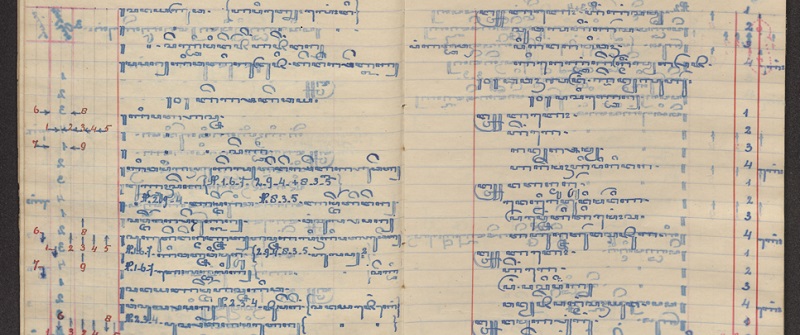
27 May Blog: Remember the dance: Viewing history through the notebook of a Yogyanese dance master
By Clara Brakel.
The notebook of a Yogyanese dance master might not seem an obvious source for deepening our historical perspectives. And yet the notation of a female bedhaya court dance (pèngetan beksa), which I received in 1973 during one of my earliest visits to Indonesia, gives a unique Javanese view of the transition from colonial government to Indonesian Republic and the centrality of Yogyakarta in this formative era.
The simple exercise book in which the score of a female court dance entitled Bedhaya Jatiwarna is written in Latin characters was offered to me by G.B.P.H. Soerjobrongto, the brother and private secretary of the then reigning Sultan Hamengku Buwana IX. Having been educated in Dutch schools in colonial times, the Prince, speaking in eloquent Dutch, told me how from an early age he had trained as a Javanese court dancer. As a young man, he had performed in the famous, large-scale wayang wong performances in the kraton of Yogyakarta, and throughout his life, Pangeran Soerjobrongto remained devoted to classical Yogyanese court dance as a dance instructor (guru), writing articles and giving lectures on its philosophy.
In a letter dated 23 December 1973, the Prince told me that the author of this notebook was his father-in-law, Raden Mas Dutadipradja, who was a court dance master and had copied it from kraton manuscripts written during the reign of his father, Sultan Hamengku Buwana VIII. In fact, the Prince suggested that I should look for more information on bedhaya compositions in the manuscript collections of the Yogyakarta kraton library.
Several years later, with the Sultan’s permission, I visited the kraton libraries and investigated the dance manuscripts in the Krida Mardawa collection, housed to the West of the Kesatriyan Pendhapa, where rehearsals of dance and gamelan music were held. (Other manuscripts were kept in the Widya Budaya collection.) And indeed, I did find a manuscript entitled Pèngetan Beksa Lelangen Dalem Bedaya Srimpi, with a more complete score of the same Bedhaya Jatiwarna. An introduction to the Krida Mardawa score stated that this dance was composed by K.R.T. Purbadiningrat, a high-ranking court servant (abdidalem). Moreover, it said that the notation was made at the Sultan’s request by four noblemen who completed the work on 3 May 1952, which is more than six months after Dutadipradja’s score had been completed on 21 November 1951, and three years after the composer’s death in 1949.
In both manuscripts, the dance score of Bedhaya Jatiwarna is written in Latin characters, with a parallel notation of the main musical structures and the song text (pasindhèn bedhaya). And precisely this song text reflects the Dutch colonial political structure in its detailed description of the inauguration ceremony of Prince Dorodjatun as Sultan Hamengku Buwana IX on 18 March 1940. The song text mentions the Javanese date: Senèn Pon, the eighth of the month of Sapar in the Dal year.
But this is not all. Dutadipradja’s notebook contains a second bedhaya score, named Bedhaya Nawunggita, written in Javanese characters by a different writer, dated 21-22 August 1953. The narration (kandha) introducing the dance states that the theme of this bedhaya was taken from the “history of the Indonesian people, from the time when they were a Dutch colony, until the return to the state of Yogyakarta, which has now become the centre of Indonesia”. The song text itself describes the Indonesian struggle for independence in colonial times, the Japanese occupation and the liberation from Dutch colonial rule through the intervention of the United Nations. As Bedhaya Nawunggita was composed for the 35th anniversary of Krida Beksa Wirama, a dance institution outside the court, its score is not kept in Yogyakarta kraton collections. Yet as a ritual dance that used to be the prerogative of the court, Bedhaya Nawunggita expresses its own view on historical events, emphasizing the central role of the Sultan of Yogyakarta in the new Indonesian Republic.
Illustration: Bedhaya Nawunggita score in the note-book of Raden Mas Dutadipradja, Or. 27.657, Leiden University Library.
Clara Brakel, senior researcher of Asian Performing Arts located in Leiden, is presently preparing a publication on the Bedhaya Jatiwarna. She is interested in Javanese dance, theatre and music, Oral traditions in North Sumatra and cultural connections between Southeast Asia, mainland Asia and the Middle East.




No Comments